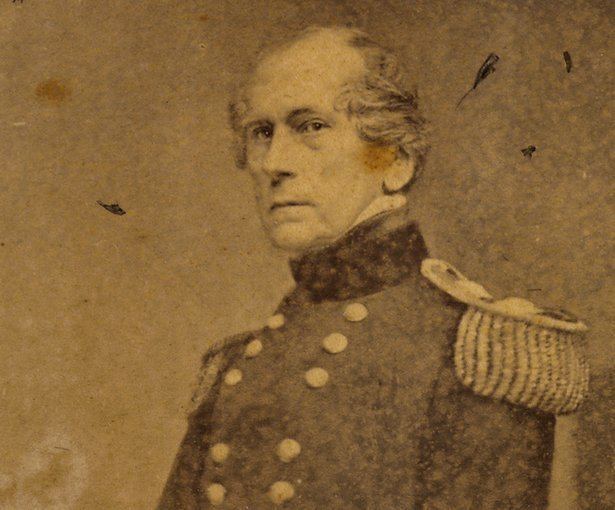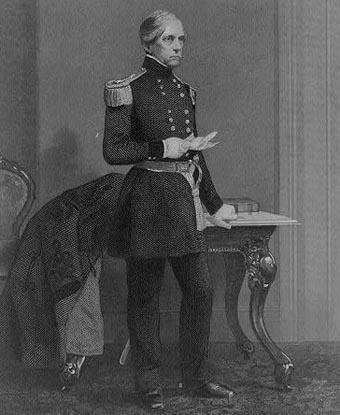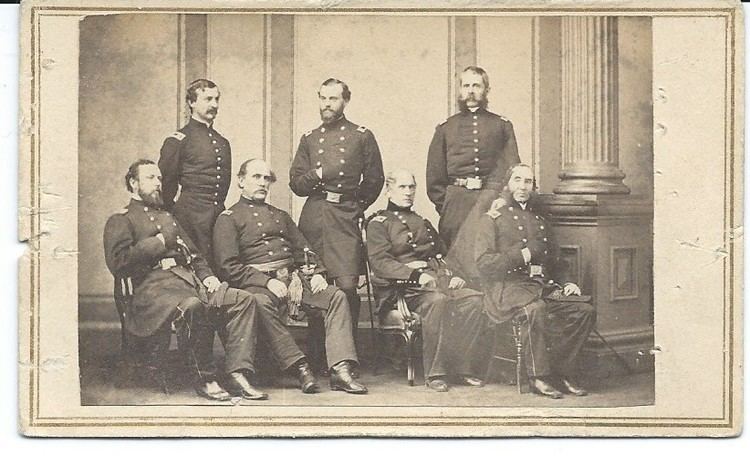Years of service 1812 - 1863 Rank Major General | Name John Wool | |
 | ||
Similar People Zachary Taylor, Pedro de Ampudia, Antonio Lopez de Santa An, Jefferson Davis, Manuel Maria Lombardini | ||
John Ellis Wool (February 20, 1784 – November 10, 1869) was an officer in the United States Army during three consecutive U.S. wars: the War of 1812, the Mexican-American War and the American Civil War. By the time of the Mexican-American War, he was widely considered one of the most capable officers in the army and a superb organizer.
Contents
- Early life and education
- War of 1812
- Staying on with the US Army
- Mexican American War and Oregon
- Civil War
- Retirement and death
- References
He was one of the four general officers of the United States Army in 1861, and was the one who had the most Civil War service. When the war began, Wool, age 77 and a brigadier general for 20 years, commanded the Department of the East. He was the oldest general on either side of the war.

Early life and education

John Ellis Wool was born in Newburgh, New York. When he was orphaned at a young age, he went to live with his grandfather, James Wool, in Troy, New York. He attended a local school and, at the age of twelve, began working at a store in Troy. He later read the law with an established firm in order to learn and be admitted to the bar.
War of 1812

At the outbreak of the War of 1812, Wool was a practicing attorney in Troy, New York.
When he volunteered at the age of 28, he was commissioned as a captain in the 13th United States Infantry Regiment on April 14, 1812. He fought at the Battle of Queenston Heights in 1812, where he was shot through his thighs. During the action, he led a group of American soldiers up a fisherman's path to the British artillery stationed on top of the heights. In the face of an infantry charge led by famed British general Isaac Brock, he rallied his men and they held their ground. The attack was repulsed, in which action Brock died. However, the Americans eventually lost the battle.
After recovering from his wound, Wool was promoted major of the 29th United States Infantry Regiment on April 13, 1813, which he led with distinction at the Battle of Plattsburgh in 1814. After the battle, he was a major of the 6th United States Infantry as of May 17, 1815. As this war was coming to an end, John Ellis Wool was promoted to the rank of Brevet Lieutenant Colonel on September 11, 1814.
Staying on with the U.S. Army
An orphan with little formal education, Wool remained in the military service and was sent to Europe to observe foreign military organizations and operations. He was promoted to colonel and Inspector General of the Army on April 29, 1816. He also participated in the removal of the Cherokee from Georgia and Tennessee in the 1830s. As part of this effort, he established Fort Butler at present-day Murphy, North Carolina as the eastern headquarters of the military removal of the Cherokee. In 1841, Wool was promoted to brigadier general in the U.S. Army and years later in 1847 made commander of the Department of the East.
Mexican-American War and Oregon
He was assigned command of the Center Division and led the Chihuahuan Expedition, which resulted in the capture of Saltillo. After leading his troops 900 miles from San Antonio, Texas, he joined General Zachary Taylor at the Battle of Buena Vista. Wool's leadership was recognized with a Congressional sword, a vote of thanks, and the brevet of major general. After the battle, he commanded the occupation forces of northern Mexico.
He commanded both the Department of the East and the Department of the Pacific at the end of the war. The first he would command in 1847-1854 and again in 1857-1860; the second he would command in 1854-1857.
While in charge of the U.S. Army Department of the Pacific, General Wool contributed extensively to the settling of the Indian Wars in Oregon, especially the Rogue River Indian War. He came into the conflict late, after the Oregon territorial government was formed and the Volunteer Militias had committed many acts of genocide against the tribes in southwestern Oregon Territory (including present-day Washington). Based in California, General Wool wrote to local papers with his opinions of the Oregon situation. Generally he defended the Indian tribes and condemned that acts of the militias. The federal government decided to undertake Indian removal to reservations in order to save them from further violence from the settlers, and Wool was to carry it out. Wool wrote to the Territorial Governor Isaac Stevens about the conflicts:
(From General John E. Wool (Department of the Pacific) to Governor Stevens (Washington Territory), February 12, 1856.)
... the war against the Indians will be prosecuted with all vigor, promptness and efficiency, I am master of, at the same time without wasting, unnecessarily, the means and resources at my disposal, by untimely and unproductive expeditions.
With the additional force which recently arrived at Vancouver and the Dalles, I think I shall be able to bring the war to a close in a few months, provided the extermination of the Indians, which I do not approve of, is not determined on, and private war prevented, and volunteers withdrawn from the Walla Walla country.
Whilst I was in Oregon, it was reported to me, that many citizens, with due proportion of volunteers, and two newspapers, advocated the extermination of the Indians- This principle has been acted on in several instances without discriminating between enemies and friends, which has been the cause, in Southern Oregon, of sacrificing many innocent and worthy citizens, as in the case of Maj. Lupton and his party (volunteers) who killed 25 Indians, eighteen of whom were women and children. These were friendly Indians on their way to their reservation, where they expected protection from the whites. This barbarous act is the cause of the present war in the Rogue River country, and as Capt. Judah, U.S.A. reports, is retaliatory of the conduct of Maj. Lupton.
By the same mail which brought me your communication, I received one, now before me, from a person whom I think incapable of misrepresentation, which informs me that the friendly Cayuses are every day menaced with death by Gov. Curry’s volunteers. The writer says that they have despoiled these Indians- who have so nobly followed the advice of Mr. Palmer, to remain faithful friends to the Americans- of their provisions. Today, he says, these same volunteers, without discipline and without orders, are not satisfied with rapine and injustice, and wish to take away the small remnant of animals and provisions left. Every day they run off the horses and cattle of the friendly Indians. They have become indignant, and will not be much longer restrained from resisting conduct unworthy of the whites, who have made them so many promises to respect and protect them if they remain faithful friends. The writer further says, if the volunteers are not arrested in their brigand activities, the Indians will save themselves by flying to the homes of their relatives, the Nez Perces, who have promised them help, and then all Indians of Oregon and Washington will join in the common defense, This information is, in great measure, confirmed by a person who, I am assured enjoys your respect and confidence.
I need not say, although I had previously instructed Col. Wright to take the Walla Walla country at the earliest moment practicable, that I directed him to give protection to the Cayuses from the depredations of the volunteers. It is such conduct as here complained of, that irritated and greatly increases the ranks of the hostile tribes, and if the Nez Perces join in war against us, which I hope to prevent, we shall require a much larger force than we now have in Washington and Oregon Territories to resist savage barbarities and to protect the whites.
Civil War
When the Civil War began in April 1861, Wool had just turned 77 years old, two years older than commander-in-chief of the US Army Winfield Scott. Unlike Scott, who suffered from obesity, gout, and other ailments, Wool was still reasonably fit and could mount a horse.
Thus in August 1861, John Ellis Wool was named commander of the U.S. Army Department of Virginia an Office that he would hold until June 1862. He moved to equip some of the first regiments sent from New York to the nation's capital and his quick and decisive moves secured Fort Monroe, Virginia, for the Union when other military installations in the South were falling to Confederate forces. The fort guarded the entrance to the Chesapeake Bay and the James River, overlooking Hampton Roads and the Gosport Navy Yard, which the Confederates had seized. It was to serve as the principal supply depot of Maj. Gen. George B. McClellan's Peninsula Campaign. The septuagenarian Wool thought McClellan was not aggressive enough in his push towards Richmond and in May 1862, he sent troops to occupy the Navy yard, Norfolk, and the surrounding towns after the Confederates abandoned them. The 16th U.S. President, Abraham Lincoln personally witnessed the capture of Norfolk and afterwards rewarded Wool by promoting him to a full major general in the regular army thereby becoming only the 23rd man to hold this rank since its creation in 1791.
Deciding that Wool should have a less demanding assignment at his advanced age, the president transferred him to be the 2nd Commander of the Middle Department in June 1862, which then became the VIII Corps on July 22, 1862. J.E. Wool then served as the 1st Commander of the U.S. Army 8th Corps until December 22, 1862. On January 3, 1863, he again assumed command of the Department of the East where he served until July 18, 1863.
But eventually Wool managed to find his way back into action. After the Battle of Gettysburg, he led troops diverted from that region in military operations to regain control in New York City during and after the draft riots in July of that year. US troops reached the city after rioters had already destroyed numerous buildings, including the Colored Orphan Asylum, which they burned to the ground. Despite the tiny force he had on hand, Wool managed to contain the situation until reinforcements arrived. Thus during July 13–17 of 1863, Wool was the de facto Military Commander of New York City.
On August 1, President Lincoln sent an order retiring Wool from service after 51 years in the Army. At the age of 79, he was the oldest general officer to execute active command in either army during the war.
Retirement and death
Wool, who believed he was still healthy and fit enough for duty, was stunned and outraged at his dismissal and wrote a series of letters to the War Department in protest, but to no avail. He continued sending letters for the remaining few years of his life to the then President Andrew Johnson and Ulysses Grant, again without effect.
Wool lived in Troy, New York for the remaining five years of his life, dying on November 10, 1869. He was buried there in Oakwood Cemetery. An obelisk was erected as a monument to Wool at the cemetery.
